
Pablo Ruiz Picasso was a Spanish painter, sculptor, printmaker, ceramicist and theatre designer who spent most of his adult life in France. One of the most influential artists of the 20th century, he is known for co-founding the Cubist movement, the invention of constructed sculpture, the co-invention of collage, and for the wide variety of styles that he helped develop and explore. Among his most famous works are the proto-Cubist Les Demoiselles d'Avignon (1907), and the anti-war painting Guernica (1937), a dramatic portrayal of the bombing of Guernica by German and Italian air forces during the Spanish Civil War.

Tourism in Spain is a major contributor to national economic life, contributing to about 11.8% of Spain's GDP. Ever since the 1960s and 1970s, the country has been a popular destination for summer holidays, especially with large numbers of tourists from the United Kingdom, Ireland, Turkey, France, Germany, Italy, the Benelux, and the United States, among others. Accordingly, Spain's foreign tourist industry has grown into the second-biggest in the world.

Et in Arcadia ego is a 1637–38 painting by Nicolas Poussin (1594–1665), the leading painter of the classical French Baroque style. It depicts a pastoral scene with idealized shepherds from classical antiquity, and a woman, possibly a shepherdess, gathered around an austere tomb that includes this inscription. It is held in the Louvre.

Noli me tangere is the Latin version of a phrase spoken, according to John 20:17, by Jesus to Mary Magdalene when she recognized him after his resurrection. The biblical scene has been portrayed in numerous works of Christian art from Late Antiquity to the present. The phrase has also been used in literature, and later in a variation by military units since the late 18th century.
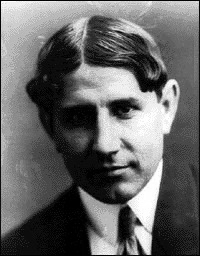
Pablo Emilio or Pau Emili Gargallo, known simply as Pau or Pablo Gargallo, was a Spanish sculptor and painter.

Guernica is a large 1937 oil painting by Spanish artist Pablo Picasso. It is one of his best-known works, regarded by many art critics as the most moving and powerful anti-war painting in history. It is exhibited in the Museo Reina Sofía in Madrid.
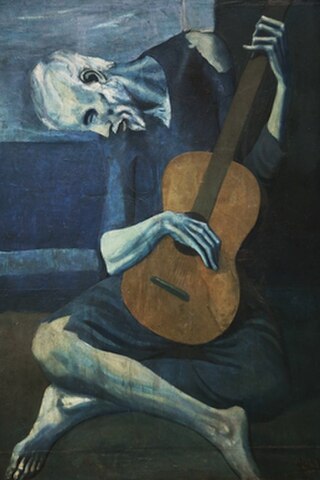
The Blue Period is a term used to define the works produced by Spanish painter Pablo Picasso between 1901 and 1904 when he painted essentially monochromatic paintings in shades of blue and blue-green, only occasionally warmed by other colors. These somber works, inspired by Spain and painted in Barcelona and Paris, are now some of his most popular works, although he had difficulty selling them at the time.

The Old Guitarist is an oil painting by Pablo Picasso, which he created in late 1903 and early 1904. It depicts an elderly musician, a haggard man with threadbare clothing, who is hunched over his guitar while playing in the streets of Barcelona, Spain. It is on display at the Art Institute of Chicago as part of the Helen Birch Bartlett Memorial Collection.

Julio González i Pellicer, born in Barcelona, was a Spanish sculptor and painter who developed the expressive use of iron as a medium for modern sculpture. He was from a lineage of metalsmith workers and artists. His grandfather was a goldsmith worker and his father, Concordio González, a metalsmith worker who taught him the techniques of metalsmith in his childhood years. His mother, Pilar Pellicer Fenés, came from a long line of artists.
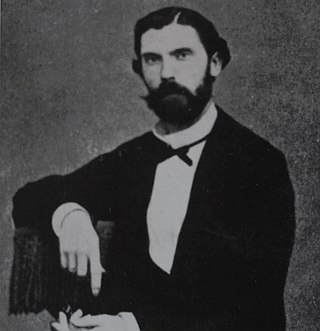
José Ruiz y Blasco was a Spanish painter, an art teacher, and the father of artist Pablo Ruiz Picasso (1881–1973).

Bartolomé Bermejo was a Spanish painter who adopted Flemish painting techniques and conventions. Born in Cordoba, he is known for his work in the Crown of Aragon, including the Principality of Catalonia and the Kingdom of Valencia. His real name was Bartolomé de Cárdenas: the name Bermejo, which means auburn in Spanish, possibly relates to his hair colour. Bermejo may relate also to his name, Cardenas; Cardeno means purplish.
Candidus (Bruun) of Fulda was a Benedictine scholar of the ninth-century Carolingian Renaissance, a student of Einhard, and author of the vita of his abbot at Fulda, Eigil.
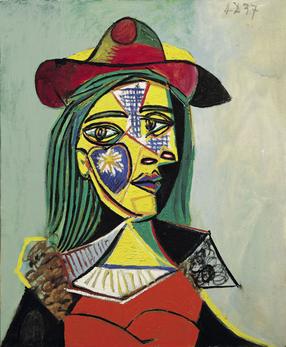
The Woman in Hat and Fur Collar is a painting by Pablo Picasso executed in 1937 and exhibited at the National Art Museum of Catalonia in Barcelona, Spain.
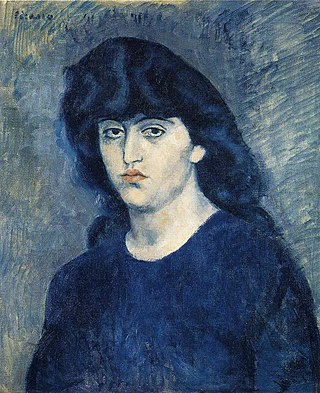
Portrait of Suzanne Bloch is an oil on canvas painting executed by the Spanish artist Pablo Picasso in Paris in 1904, towards the end of his Blue Period. The subject, Suzanne Bloch, was a singer known for her Wagner interpretations, and the sister of the violinist Henri Bloch. The painting is housed in the São Paulo Museum of Art.
Las Meninas is a series of 58 paintings that Pablo Picasso painted in 1957 by performing a comprehensive analysis, reinterpreting and recreating several times Las Meninas by Diego Velázquez. The suite is fully preserved at the Museu Picasso in Barcelona, it is known that he sold the first and second interpretations of the meninas to the American art collector Peggy Guggenheim, owner of the Art of this century gallery. This is a very extensive survey work which consists of 45 versions of the original picture, nine scenes of a dove, three landscapes and a portrait of Jacqueline.

Carles Antoni Cosme Damià Casagemas i Coll was a Spanish painter and poet. He is known for his friendship with Pablo Picasso, who painted several portraits of Casagemas. They traveled around Spain and eventually to Paris, where they lived together in a vacant studio.
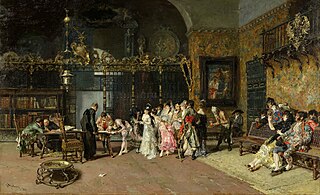
The Spanish Wedding or La Vicaría (1868–1870) is a masterwork by Marià Fortuny i Marsal, also known as Marià Fortuny or Mariano Fortuny. La Vicaría exemplifies genre painting of the 19th century. The use of jewel tones, contrasts between light and dark, and the virtuosity of the work attest to Fortuny's talent. It resides at Museu Nacional d'Art de Catalunya in Barcelona, Spain.

Science and Charity is an oil on canvas painting by Pablo Picasso, which he painted in Barcelona in 1897. It is an example of one of Picasso's earliest works, as he painted it when he was only 15 years old. The painting depicts a formal composition of a sick patient in bed, attended by a doctor and a nun holding a child. It was the culmination of Picasso's academic training and displays his talent as an artist before he moved away from this style to pursue his own artistic career. The painting is housed in the collection of the Museu Picasso, Barcelona.

Au Lapin Agile is a 1905 oil on canvas painting by Pablo Picasso. It depicts the interior of the Lapin Agile, a famous cabaret club in the Montmartre area of Paris. The composition was produced during Picasso's Rose Period and includes a self-portrait of the artist who frequented the club in his youth. The painting is listed as one of the most expensive paintings after achieving a price of $40.7 million at Sotheby's auction on 27 November 1989. It is housed in the collection of the Metropolitan Museum of Art in New York City.
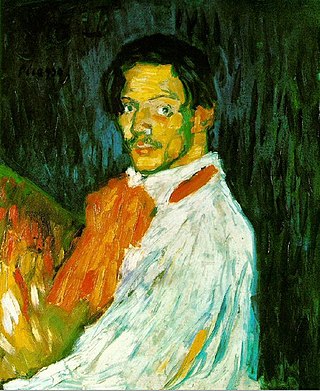
Yo, Picasso, is an oil-on-canvas painting by Pablo Picasso, which he painted in 1901. It is a self-portrait of the artist that depicts him in his youth, aged 19. The painting was created at the beginning of Picasso's Blue Period. On 9 May 1989, the painting sold at Sotheby's, achieving a price of $47.85 million, making it one of the most expensive paintings sold up to that date.


















